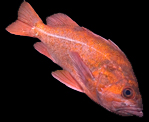
Harbor seal, Phoca vitulina
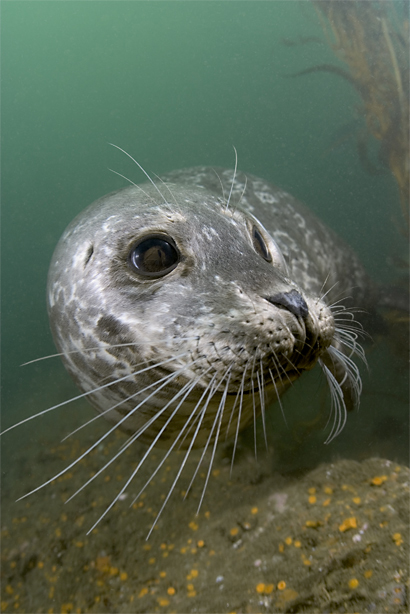
Always wary, harbor seals (Phoca vitulina) spend a great deal of time
scooting along, just a few inches off the bottom. Presumably, this makes it
difficult for predators and prey alike to detect their presence. Since the lens
used in this shot makes the subject appear farther away than it really is, it
may not have occurred to you to wonder why this animal, merely inches from the
camera's dome port is looking at something off to the photographer's right. If I
recall correctly, the animal came this close because it was attracted to the
port itself - they're very shiny underwater. While harbor seals seem to really
like camera ports, they have something of a love/hate relationship with strobes.
On the one hand, strobes such as the YS-90s I was using on this dive are, like
ports, shiny since their outer casings are transparent. On the other hand, they
emit terrible, scary flashes. About five minutes before this shot was taken, an
itchy trigger finger got the best of me and I pressed the shutter while this
seal was still about eighteen inches away. In this position, it was looking
almost directly into the strobes and winced in obvious annoyance. I cursed
myself for being so careless, but the damage was done. In this later shot, the
seal is actually looking at one of the strobes, I suspect with some concern.
Harbor seals are quick to learn how to avoid getting hit with strobes or focus
lights. Once educated, they may still tug on your fins, chew on an offered hand,
and even check out the non-flashy sides of strobes using the universal harbor
seal kiss of investigation (lips parted, mouth closed and pressed against the
object of interest). However, raise your camera, any you'll most likely end up
with nothing but the south end of a north bound seal. Should you find yourself
in such a position, It's time to turn off the camera and just enjoy the moment.
"Tanker Reef", Monterey Bay, California
November 27, 2005
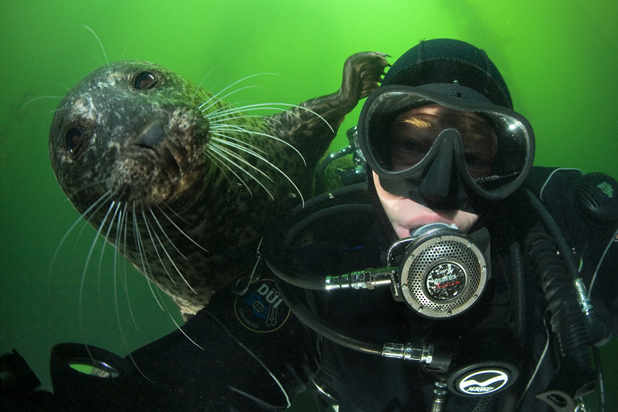
. . . and just when I was all set to take one of my very best self-portraits
ever, someone had to stick his nose in the shot and mess up everything! This
harbor seal (Phoca vitulina) is doing a pretty good job of pushing me
aside. Yes, those are his claws on my head. And yes, they're sharp and can be
felt through a drysuit hood, even the half-inch one I'm wearing. Note the
quarter-inch of water in the bottom of my mask. This is a side-effect of
roughhousing with the fuzzball -- or maybe it's just from an intense fit of the
giggles. This guy is quite the bully, actually. On this dive I'd spent over an
hour playing with a seal that was bit by bit working up enough the courage to do
something more than sneak up from behind to give a little fin tug. A few seconds
before this shot was taken, this original animal was chased off by the snarls of
the animal pictured. Proof, I guess, that competition in nature can be pretty
fierce, even in the pursuit of leisure -- and, I'm pretty sure this is what they
have in mind. Certainly, I'm sure they've figured out by now that my fins aren't
edible. You can't actually see my fins in this shot, you can clearly see some of
the other gear choices I've made (both good and bad). You'll have to indulge me
as I blab about dive gear for a bit. If you don't want to humor me in this
regard, well, then you can just move on to the next caption or something. First
off, photographers (artists that we are) often dress entirely in black. Clearly
that's what I'm doing. Black is pragmatic, (it doesn't show dirt and all), but
is a poor choice if you're going to be someone else's model. Everything black
gets swallowed up into one giant blob. Worse yet, every teeny, eeny, bit of
backscatter looks like a great big honking chunk when it's in front of a black
background. When choosing a color, consider blue, it looks great. My next suit?
Black with white speckles. Why? It's the only color in which the material I
wanted is available. At least, maybe the backscatter will be hidden among all
the speckles. The hood I'm wearing is a custom Otter Bay Wetsuits hood. Pure
genius, these hoods. You have no excuse for not owning one -- well, maybe if you
live in Nebraska you have an excuse, but certainly not if you're a diver, cold
or warm water. The one catch with the Otter hood is that it comes with a giant
Otter Bay logo. I could do without this, I consider it to be in much the same
league as license plate frames emblazoned with a auto dealer's name. I own dry
gloves which are bright blue -- again due to limited availability of colors.
While these have unintentionally made their appearance in far more than one shot
they thankfully can't be seen in a standard self-portrait like this one. This
mask is proof that the best gear is not always the most expensive. In fact,
apart from what you find at the drug store, this Oceanic Mini Shadow is about
the least expensive mask I've seen. If it fits you, buy one. If it doesn't
there's a non-mini version of the same mask so you might try that one. If that
doesn't fit either, then, well, too bad for you. I should admit that while I
don't represent Oceanic in any formal capacity, they have been paying customers
in the past. It's still a good mask, you have my word on it. Of course, I've
made some not-so-good gear choices also. Take the primary regulator I'm using
here (the thing in my mouth). It's plated with 100% pure unobtainium so it was
really spendy. Why? No reason, I just couldn't stand the thought that somewhere,
somehow, there might maybe be someone with more expensive gear than mine. Dive
gear manufactures are fond of such gimmicks. With a little bit of rational
thought (hard for some of us, I know) it shouldn't be too hard to avoid most of
these.
"Tanker Reef", Monterey Bay, California
October 22, 2006
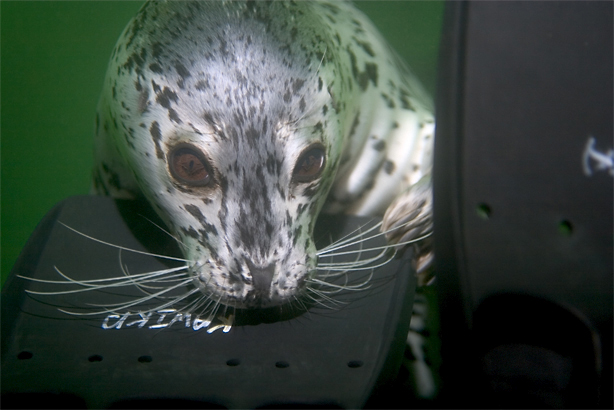
Photographer's fins and a furry dive companion with a foot fettish. A harbor
seal (Phoca vitulina) may introduce itself by biting and pulling on a
diver's fins. The pull feels quite similar to entanglement in kelp. This,
coupled with the fact that these animals are quite capable of vanishing from
view faster that one can turn around has often led me to wonder if I was having
hallucinations. I've felt tugs three, four, five times during a dive, before
catching a glimpse of the culprit. Eventually, the nibbler may work up the
courage to move beyond just fins. I've had seals tuck themselves under my arm,
or mouth hands, lights, and camera strobes. On several occasions I've even seen
them belly up in front of me in seeming demand of a tummy rub. Harbor seals seem
to treat contact with their own swimming flippers (though not their forward,
steering ones) as a sign of aggression. Perhaps this isn't surprising since a
seal with disabled hind flippers would almost certainly be unable to hunt and
would therefore perish. It may then be that fin nibbling is some kind of mock
dominance or a way to test the disposition of unfamiliar creatures. It may also
be that these young animals are simply practicing a defense skill that they'll
use throughout their lifetime. On one occasion, I was chased off -- away from
what, I'm not entirely sure -- by an adult harbor seal who nipped at my ankles
(not fins) with real force.
"Tanker Reef", Monterey Bay, California
September 4, 2005
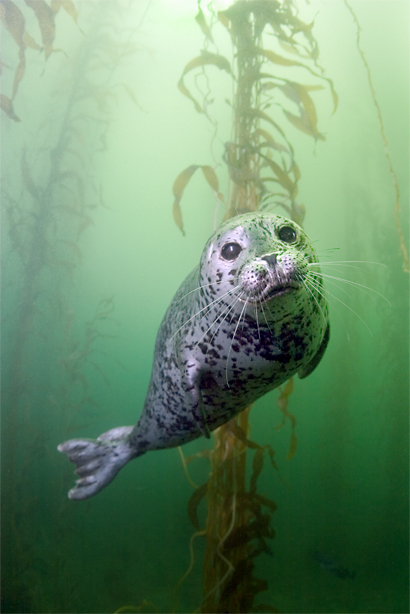
Harbor seals (Phoca vitulina) seem to expend almost no effort as they
glide through the kelp forest. However, it's uncommon to get a view like this
one. These animals, even when in the mood to play, will almost always approach
such that a would-be photographer doesn't see them coming. There was a little
bit of chicanery and a fair bit of luck involved in getting this pup to pose
like this.
"Tanker Reef", Monterey Bay, California
September 24, 2005
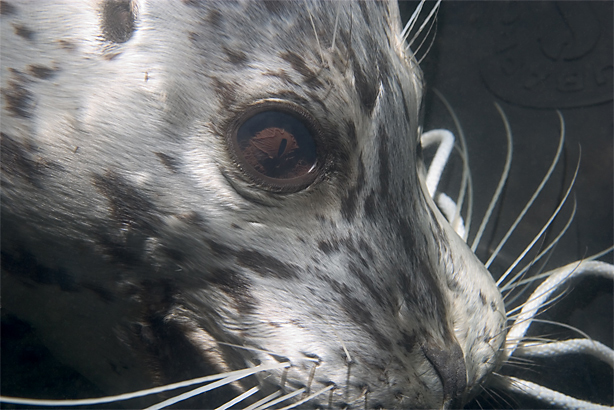
Ever seen a harbor seal (Phoca vitulina) tie a pair of shoes? . . . Me
neither. However, as this photo demonstrates, they are quite adept at UNtying
them. Other harbor seal skills (not pictured) include a knack for removing masks
and drysuit hoods, and, a disturbing ability to dislodge boat anchors from their
resting place in the sand.
"Tanker Reef", Monterey Bay, California
September 18, 2005
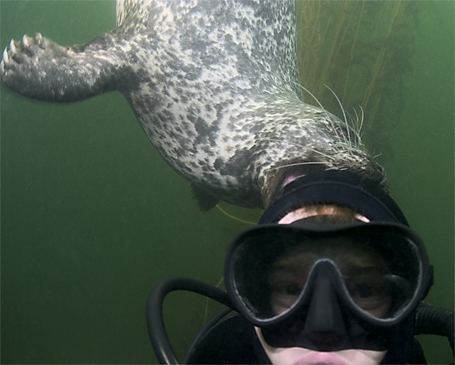
Self-portrait of me having something of a bad hair day. Yes, I had a horrible
headache after this dive. This rather interesting harbor seal (Phoca
vitulina) behavior isn't nearly as threatening as it appears. On one
occasion, however, a seal managed to work a tooth under the stitching of my
drysuit hood. This gave the animal an excellent purchase and a battle for
possession of my hood (and mask!) ensued.
"Tanker Reef", Monterey Bay, California
October 8, 2005









